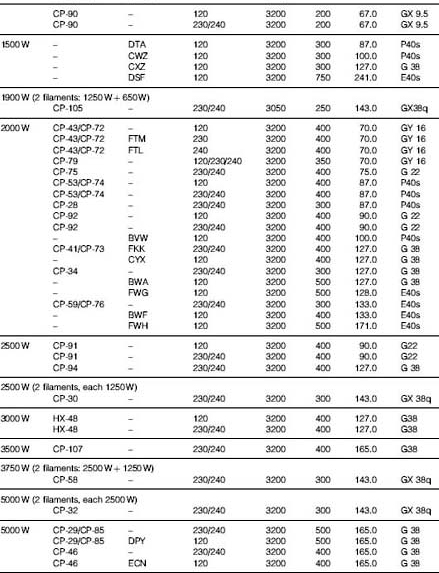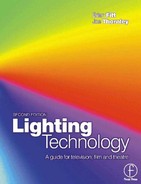Appendix III
Lamp tables
Incandescent lamps
In general, incandescent lamps for film, TV and theatre in Europe can be divided into three groups, having the codes of CP, P and T. The designations are given by the Lighting Industries Federation (LIF) and are broadly described as follows:
| CP | Originally stood for Colour Photography, because the first lamps were imported from the USA by the film industry. All CP lamps are 3200 K and are single ended, ranging in size from 300 to 20 000 W. |
| P | This class of lamps are also 3200 K but they are linear, double ended types, ranging in size from 250 to 2000 W. |
| T | Indicates lamps designed for theatre, because they are of the order 2900-3000 K with an appropriately longer life, ranging in size from 500-2000 W. |
The American National Standards Institute (ANSI) have a different coding system, being three letters arranged in alphabetical order. The cross reference table gives the equivalent types in both systems and can be used not only as a substitute guide, but also to help the user to find alternative lamps of different wattage and voltage for his luminaire. To do this, identify the lamp base and the Light Centre Length (LCL) and look for alternative lamps that have the same; but care must be taken not to exceed the maximum rated wattage of the luminaire as this will cause the lamp to overheat and shorten its life and can damage the housing and present a safety hazard. It is also extremely important that lamps designated as having ‘pinch protection’ should only be used in luminaires designed for them. (See Pinch protected lamps – Section 2)
The tables have been collated from many different manufacturers’ catalogues so it is not an easy task to select one catalogue and expect to find that it provides information on all types of lamps, but a good wholesaler should have the required information, if you supply him with the code and the voltage required. When ordering lamps for Europe, be careful to specify 230 V or 240 V because if 230 V lamps are used at 240 V, the life will be reduced to only 60% of the manufacturers’ stated life.
In the tables that follow the lamps’ light centre lengths are given in millimetres, life is given in hours and the colour temperature is in Kelvin degrees.
1 Single ended tungsten halogen Incandescent lamps




2 Special ‘pinch protected’ tungsten halogen lamps
The lamp manufacturers state that ‘pinch protected’ lamps should only be used in dedicated ‘pinch protected’ luminaires and under no circumstances should they be used in existing standard luminaires. This is because ‘pinch protected’ lamps have either a shorter ‘light centre length’ than normal or a higher wattage for the same LCL to enable manufacturers to design smaller luminaires. If used in standard luminaires over-heating of the lamp and/or housing could result, e.g. fitting a ‘pinch protected’ 2 kW lamp with a G 22 base into a standard 1 kW Fresnel which has the same base and the same LCL. The pinch temperature of a standard tungsten halogen lamp is typically 400°C, whereas ‘pinch protected’ lamps can work at temperatures up to 500°C.

Note: Especially developed for high luminaires.
3 Double ended tungsten halogen incandescent linear lamps


4 PAR sealed beam incandescent tungsten halogen lamps

Discharge Lamps
CAUTION: When selecting an alternative discharge lamp consult the luminaire/ballast manufacturer or his representative for a suitable replacement. Lamps of the same rating may have different operating characteristics or may be ‘hot restrike’ (instant restart) which require higher ignition voltages.
1 Double ended linear discharge lamps

2 Single ended linear discharge lamps

3 PAR sealed beam discharge lamps

4 Special application discharge lamps


